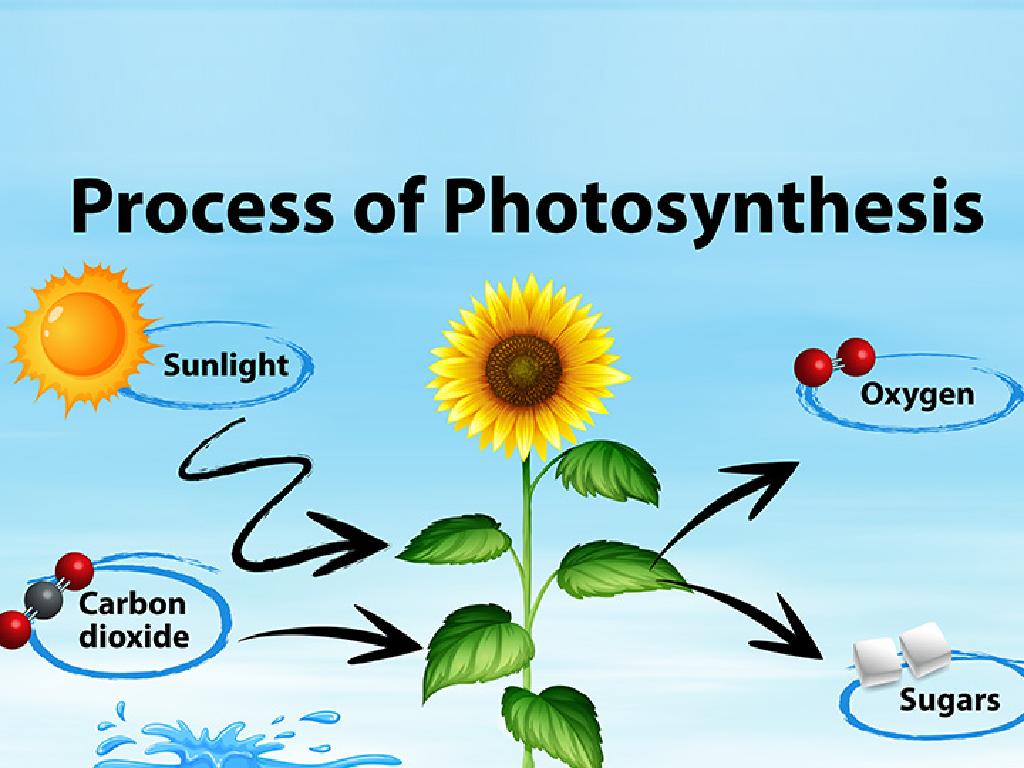Understand An Experimental Protocol About Diffusion
Subject: Science
Grade: Sixth grade
Topic: Designing Experiments
Please LOG IN to download the presentation. Access is available to registered users only.
View More Content
Understanding Experimental Protocols: Diffusion
– Define diffusion in science
– Movement of particles from high to low concentration
– Explore diffusion’s role
– Essential for processes like breathing and smelling
– Discuss diffusion’s importance
– Helps explain how substances move in nature
– Engage with a diffusion experiment
|
This slide introduces the concept of diffusion as part of understanding experimental protocols in science. Begin by defining diffusion as the movement of particles from an area of higher concentration to an area of lower concentration. Highlight how diffusion plays a crucial role in everyday processes such as breathing, where oxygen diffuses into blood, and smelling, where scent particles spread in the air. Emphasize the importance of diffusion in scientific studies, as it helps explain the movement of substances in biological and environmental systems. Conclude with an interactive class experiment to observe diffusion in action, such as using food coloring to see how it spreads in water. This will provide a practical understanding of the concept and its significance in science.
Understanding Experimental Protocols in Diffusion
– Define experimental protocol
– A set of procedures for conducting an experiment
– Protocols ensure consistency
– Protocols maintain experiment reliability and validity
– Key elements of protocols
– Includes hypothesis, materials, procedure, and data analysis
– Application in diffusion experiments
– Example: observing dye spread in water to study diffusion
|
An experimental protocol is a detailed plan that outlines the steps and procedures to be followed in a scientific experiment. It’s crucial for ensuring that experiments are consistent, reliable, and can be replicated by other scientists. Key elements include a clear hypothesis, a list of required materials, a step-by-step procedure, and methods for data collection and analysis. In the context of diffusion, students might conduct an experiment to observe how a substance like dye spreads through water, which illustrates the process of diffusion. This slide will help students understand the importance of following a structured approach when designing and conducting experiments.
Understanding Diffusion in Science
– Diffusion: movement from high to low concentration
– Particles move to even out concentration, like a drop of food coloring spreading in water.
– Everyday examples of diffusion
– Smelling perfume across a room, tea brewing in hot water.
– Diffusion’s role in biology
– Oxygen entering cells, waste leaving cells.
– Why diffusion is important
|
This slide aims to explain the concept of diffusion to sixth-grade students. Begin with the definition of diffusion, ensuring students understand that it’s a natural process of particles spreading from an area where they are more concentrated to an area where they are less concentrated. Provide relatable examples such as the scent of perfume dispersing in a room or a teabag diffusing in hot water. Highlight the significance of diffusion in biological systems, such as how cells receive oxygen and get rid of waste. Emphasize the importance of understanding diffusion as a fundamental principle in science that explains many natural phenomena.
Experimenting with Diffusion
– Outline steps for a diffusion experiment
– Identify the purpose, hypothesis, and variables
– Select appropriate materials and methods
– Choose substances that visibly change (e.g., food coloring in water)
– Make predictions on the outcomes
– Based on known information, what might happen?
– Anticipate possible observations
– What changes should you look for during the experiment?
|
This slide is aimed at guiding students through the process of designing a simple diffusion experiment. Start by discussing the steps involved in any scientific experiment: defining the purpose, forming a hypothesis, and identifying variables. Next, move on to selecting materials that will clearly show the process of diffusion, such as using food coloring to diffuse in water. Encourage students to use their knowledge of diffusion to predict what they expect to happen and to think critically about what they will observe, such as the speed and pattern of the color spreading. This exercise will help them understand the scientific method and the specific phenomenon of diffusion.
Understanding Diffusion: Experimental Protocol
– Overview of a diffusion experiment
– A guided procedure to observe how substances mix over time without stirring
– Comprehend each protocol step
– Each step, from setup to observation, is crucial for accurate results
– Precision in protocol adherence
– Exact measurements and timing ensure replicable and valid outcomes
– Significance of following protocol
– Adhering to the protocol is essential for scientific validity and safety
|
This slide introduces students to the concept of an experimental protocol within the context of a diffusion experiment. It’s important to convey that a protocol is a set of detailed instructions that must be followed precisely to ensure the experiment’s success. Emphasize the importance of understanding each step, from the initial setup to the final observations, and how careful adherence to the protocol ensures accurate and reliable results. Discuss the significance of precision in scientific experiments, particularly in measuring and timing, to allow for the experiment to be replicated and validated by others. Encourage students to ask questions about each step and discuss why it might be important for the overall experiment.
Conducting the Diffusion Experiment
– Teacher demonstrates the experiment
– Watch closely as the teacher mixes substances
– Observe diffusion process
– Look for how substances spread out over time
– Record observations systematically
– Use charts or tables to note changes
– Discuss findings and data
– Share what you’ve noticed with the class
|
This slide is designed to guide students through a hands-on diffusion experiment. The teacher will first demonstrate the experiment, showing how substances like food coloring in water spread out over time due to diffusion. Students should observe the process carefully, noting how the color moves and changes the water’s appearance. They should record their observations in an organized manner, using charts or tables to track the diffusion over time. Encourage students to pay attention to details and to think about why diffusion happens. After the experiment, facilitate a discussion where students can share their data and talk about what they’ve learned about diffusion. This will help them understand the concept of diffusion and how to record scientific observations.
Analyzing Diffusion Experiment Results
– Analyze diffusion data
– Look at the changes over time and patterns
– Interpretation of results
– What do the patterns indicate about how diffusion works?
– Identify sources of error
– Common errors: temperature changes, measurement mistakes
– Impact of errors on results
– Errors can alter the speed and pattern of diffusion observed
|
In this slide, we focus on the critical thinking aspect of scientific experiments by analyzing and interpreting data from a diffusion experiment. Students should learn how to examine the data for patterns that reveal how diffusion occurs over time. They should understand that the results can provide insights into the rate and direction of diffusion. Discussing potential sources of error, such as fluctuations in temperature or inaccuracies in measurement, is crucial as these can significantly affect the experiment’s outcomes. Emphasize the importance of recognizing and accounting for these errors when conducting experiments. This discussion will help students grasp the concept of experimental reliability and validity. Encourage students to think about how they might improve the experimental design to minimize these errors in future experiments.
Class Activity: Design a Diffusion Experiment
– Form small groups for the activity
– Create a protocol to test Diffusion
– Use materials like a beaker, food coloring, and water
– Present your protocol to the class
– Engage in a class vote on the best protocol
– Consider clarity, detail, and creativity in each protocol
|
This activity aims to foster teamwork and understanding of experimental design focused on the concept of diffusion. Each group will use common classroom materials to devise a simple yet effective protocol to observe diffusion in action. After creating their protocols, students will present them to the class, explaining their rationale and the steps involved. The class will then vote on the best-designed protocol, considering how well it tests diffusion, the clarity of the steps, and the creativity involved. Teachers should provide guidance on experimental design and ensure that all students participate actively. Possible variations of the experiment could include changing the temperature of the water, using different substances to diffuse, or altering the size of the beaker to see how these variables affect diffusion.
Conclusion: Understanding Diffusion
– Recap of diffusion process
– Diffusion is the movement of particles from high to low concentration
– Significance of experimental protocol
– A clear protocol ensures accurate, repeatable results
– Engage in Q&A session
– Reflect on what we’ve learned
– Think about how diffusion occurs in real life, like smelling perfume
|
This slide aims to consolidate the students’ understanding of diffusion and emphasize the importance of following a structured experimental protocol. Begin by recapping the concept of diffusion, explaining that it’s a natural process that equalizes the concentration of particles. Highlight how a well-planned protocol is crucial for obtaining reliable experimental results and how it can affect the outcome of an experiment. Encourage students to ask questions to clear up any confusion they may have. Conclude the lesson by asking students to reflect on the importance of diffusion in everyday life and in scientific research. This reflection will help them appreciate the relevance of what they’ve learned.





